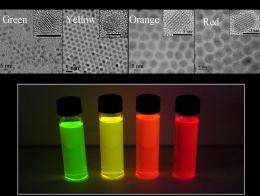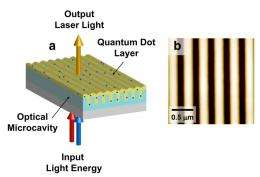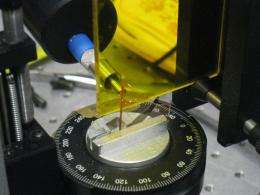Four different colours of quantum dots (photo: Raffaella Signorini, Padova University)
Imagine printing your own room lighting, lasers, or solar cells from inks you buy at the local newsagent. Jacek Jasieniak and his colleagues at CSIRO, the University of Melbourne and the University of Padua in Italy, have moved a step closer to such a future, by developing liquid inks based on quantum dots that can be used to print devices.
Imagine printing your own room lighting, lasers, or solar cells from inks you buy at the local newsagent. Jacek Jasieniak and his colleagues at CSIRO, the University of Melbourne and the University of Padua in Italy, have moved a step closer to such a future, by developing liquid inks based on quantum dots that can be used to print devices.
The first laser, invented 50 years ago in May 1960, was described as a solution looking for a problem. Today dozens of lasers are built into our computers, cars and homes. Soon, thanks to Jacek’s work, we may have millions of tiny lasers working in our homes lighting our rooms and even acting as pixels in printable TV screens. The lasers could also be used as components in optical computers, electronics, sensors, as cheap laser pointers in a range of colours or even fashion accessories.
A schematic of a quantum dot lasing device (photo: Raffaella Signorini, Padova University)
Jacek’s work is being presented for the first time in public through Fresh Science, a communication boot camp for early-career scientists held at the Melbourne Museum. Jacek was one of 16 winners from across Australia.
“Creating cheaper lasers relies heavily on progress in materials science,” Jacek says. “At present, lasers are manufactured using expensive materials and production techniques. To make them more cost effective, we have focused on developing materials that are cheap, function well as lasers, and can be printed. Quantum dots meet all these requirements.”
Quantum dots are made of semiconductor material grown as nanometre-sized crystals, around a millionth of a millimetre in diameter. The laser colour they produce can be selectively tuned by varying their size. To build a laser using quantum dots, you need to place them within a structure known as an optical cavity. This structure acts to amplify the light that is produced by the quantum dots to produce the laser.
“Conventional lasers use large optical cavities which make them impossible to use for printable lasers. To develop true nanometre-sized lasers we have employed a special type of optical cavity that consists of a repeating nano-structured pattern on the surface of the material onto which the quantum dots are printed. A major benefit of this nano-structured optical cavity is that it can be produced during the printing process by controlled indentation or scratching of the material’s surface,” Jacek says.
A prototype quantum lasing device (photo: Raffaella Signorini, Padova University)
“The tiny lasers generated using such an approach are highly efficient and can be adapted for numerous applications.”
In addition to lasers, this research has significant implications for many other future technologies which use liquid inks to develop printable components. One highly promising example is the production of thin-film solar cells, a research area that Jacek is also currently involved in at CSIRO.
Source: Fresh Science























